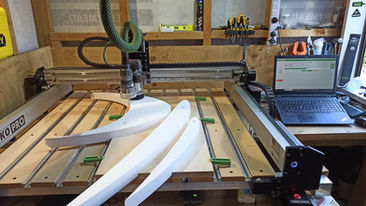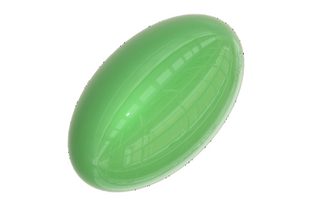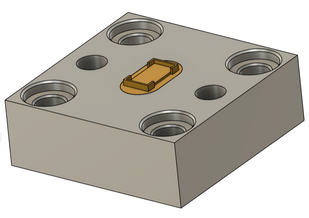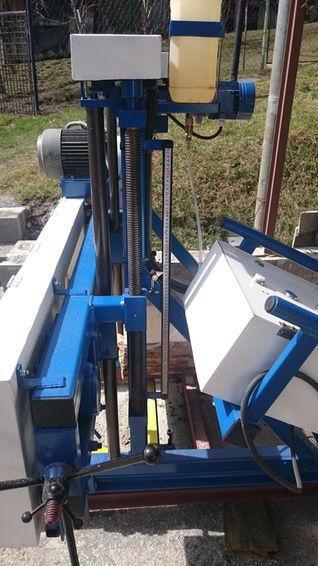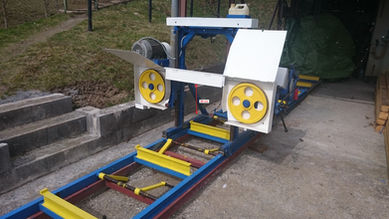PROJECTS IN DETAILS (site in development)

New Wind Turbine Design
The idea for a new turbine design grew out of my pure curiosity. I began wondering whether it was possible to overcome the limitations of traditional propeller-style wind turbines and open up new opportunities for homeowners, businesses, and communities to harness wind energy.
My goal was simple: to make wind power as accessible and practical in dense urban environments as solar panels are today.
PROBLEM:
Traditional wind turbines face several critical limitations. They rely heavily on laminar airflow, making them inefficient in turbulent, built-up environments. They also generate significant noise, are difficult to scale down effectively, and often suffer from unattractive visual design. As a result, there is currently no practical or appealing wind energy solution available for the average homeowner.
HOW:
This project involved in-depth R&D, daily learning, CFD simulations, and conducting mechanical analysis to iterate and improve the design. I proposed, designed, and manufactured most of the critical components, built two prototypes, and carried out mechanical tests of the assemblies under real-world conditions.
SOLUTION:
I proposed, designed, and developed a wind energy device with no visible moving parts, a motionless system that can be mounted on rooftops, even in densely built urban areas. The Wind Harvester operates on aerodynamic principles similar to those used by aircraft or birds in flight. Two vertical wings, positioned facing each other, generate a low-pressure zone between them. To restore pressure equilibrium, secondary airflow is drawn through an internal impeller fan, which in turn generates electricity.
RESULT:
I've successfully built the working prototype of the Wind Harvester and proved that the idea works, and the simulations weren't just theory. Witnessing the first watts of electricity generated from wind by my design was one of the most rewarding experiences I have had as an engineer. Although it's still early days, the results are promising, and I'll continue to refine the design and explore its full potential.


Modular Impeller Fan
The main body of the turbine plays a critical role in shaping airflow, but it's the impeller fan that does the hard work of turning that airflow into usable energy. Getting it right was essential. I needed to find the right combination of blade shape, pitch, size, and count to harness the full potential of the laminar stream drawn toward the turbine's low-pressure zone.
PROBLEM:
I’ll be honest: at the start, I had no idea what the final design would look like. I have never designed a fan. But I knew one thing for sure: a well-designed fan could make or break the whole system.
HOW:
I dove deep into research, prototyping, and testing, knowing that the turbine's performance would hinge on getting this one component exactly right. To maximise power output, I moved away from flat blades and began experimenting with airfoil-shaped blades that could generate additional lift from the passing airflow. This shift allowed me to extract more energy from the same wind stream.
As the fan size grew, I also had to rethink my manufacturing approach. Instead of a single-piece design, I transitioned to a modular assembly, both to overcome production constraints and to make the design easier to test and modify if necessary.
SOLUTION:
After countless hours of CFD simulations and iterative design work, I finally found the sweet spot. The right balance of blade shape, pitch, and spacing started to emerge. I also designed a precise locking system for the blades, ensuring both strength and ease of assembly. Working closely with the manufacturer, we refined the details together to bring the concept to life.
When the final parts were shipped, I was thrilled. I couldn’t wait to open the box and see the result of all that effort.
RESULT:
Through careful optimisation of the fan, I was able to improve the turbine's performance by an impressive 120%.
The smart, modular design also made it possible to manufacture the components using accessible 3D printing technology. This significantly reduced initial costs and made it far more affordable.

The Smallest NFC Tag Out There
This project marked the beginning of a fantastic collaboration with Scannable and its founder, Rob Stirling. At the time, Scannable was just starting its journey. Rob had developed a minimum viable product (MVP) that was good enough to demonstrate to investors, but he knew it needed a significant upgrade to compete on the global stage.
As luck would have it, our paths crossed right at that moment, and I landed my first real contract role since moving to New Zealand.
PROBLEM:
The first version of the carabiner NFC tag needed a serious upgrade. The second version had to be smaller, more durable, and have a modern, eye-catching design. Improvements in readability and overall reliability were also critical.
There was an additional challenge; we weren't just redesigning for I-beam carabiners. There was also an ambitious goal to create a version that could be embedded directly into climbing rope cores.
And like many early-stage startups, we faced a tight budget. Every dollar saved extended the runway, so cost-effective solutions weren't optional, they were essential.

HOW:
From the very first meeting, I had a clear vision: a compact, ergonomic tag hidden inside the carabiner I-beam, where the beam's side walls would shield it from direct impacts. To cut costs, I aimed to eliminate the expensive potting process and instead use micro-injection moulding to overmould the sensitive semiconductor directly.
However, it quickly became clear that a one-size-fits-all design wouldn't work. For the carabiner application, we needed the tag to maintain direct contact with the metal body of the carabiner to use it as an extended antenna. This meant introducing a sharp edge at the base of the tag, perfectly fine for the I-beam carabiner, but completely incompatible with rope integration. Anything sharp embedded in the rope core would fail safety certification.
As a result, we had to design two distinct products: one for I-beam carabiners and one for ropes. That decision, although necessary, meant two moulding tools, doubling the initial cost from the start.
SOLUTION:
Initially, I developed two separate products, one for carabiners and one for ropes. They were comparable in size, but their shapes differed due to the distinct requirements of each application. This meant not only double the design work but also double the tooling cost.
During a casual meeting with the manufacturer, Rob joked, "Wouldn't it be great if we could make both tags with a single moulding tool? We could save half of the trouble." At first, it was just a passing comment, something to laugh about. But that sentence stuck with me. Could we actually do it?
I opened my laptop and began redesigning the rope tag from scratch. My idea was to unify the mould's top half (the cavity), while allowing the bottom half (the core) to use interchangeable inserts. That way, we could mould two different products with a single tool and massively reduce costs.
What started as a joke sparked a deep engineering challenge and a long technical discussion with the manufacturer. But we worked through the constraints, refined the idea, and ultimately brought it to life.

RESULT:
The result? An innovative, cost-effective solution that made its way into full-scale production. We developed a product that not only entered the global market but also became an iconic part of the Scannable lineup. What began as a bold idea to retrofit existing carabiners with electronic IDs has now become a safety standard, adopted by equipment manufacturers around the world.
Thanks to the clever dual-product design, we reduced the initial tooling costs by 58% while still delivering two distinct products from a single moulding tool. It's a win that proved that even those without a long, fancy track record can deliver world-class results if given an opportunity.

NFC Carabiner Grommet
After successfully developing an NFC tag solution for I-beam carabiners, we faced a new challenge. The majority of carabiners used in the field are round-bar types, something our existing tag wasn't designed for. So Rob, Scannable's co-founder and CEO, came up with a new challenge: develop a product that would serve this untapped segment. At the time, nothing like this was available on the market, so such a product would unlock opportunities for Scannable to enter heavy industry, where durability, reliability, and performance in harsh environments are essential.
PROBLEM:
We needed to develop an NFC tag that could be easily retrofitted to safety equipment used in harsh, heavy-industry environments, such as oil rigs or offshore wind farms. Several key requirements had to be met: the tag needed to fit a wide range of carabiner bar diameters, be securely attached without the use of adhesives, and be made from a material that was durable, UV-resistant, and chemically resistant.
HOW:
At the time, we had already developed a second-generation NFC tag for I-beam carabiners, which worked perfectly. So naturally, my first thought was, "Let's adapt our existing tag and create an adjustable band for it."
In product development, you don't usually reinvent the wheel; you often borrow ideas from everyday objects and repurpose them to your needs. In this case, I drew inspiration from a snapper hose clip. It seemed like a promising direction in CAD, and the initial concept looked great on screen.
However, once I received the first 3D-printed prototypes, it became immediately clear: this wasn't the right solution.


However, I also had a second design in mind. It was a bit trickier to adapt for different carabiner sizes, but it was smaller, sleeker, and visually more appealing. We quickly decided this was the design we wanted to move forward with.
Around that time, Rob suggested an idea: what if we could use something similar to a bird's leg ring, but made from a stretchy material? That sparked a new wave of thinking. I went back to my laptop, started sketching. We also abandoned the idea of using the existing NFC tag and focused on overmoulding a semiconductor inside the grommet. A few days later, we had fresh 3D-printed prototypes that were nearly final in design.
The next step seemed straightforward: choose the right material and find a manufacturer. But in practice, it was anything but easy. Manufacturers repeatedly rejected the design, claiming it couldn't be moulded without redesign. The main issue? They couldn't figure out a way to secure the off-the-shelf NFC component in place during the injection-moulding process.
SOLUTION:
It felt like we were back at the beginning. We had a perfect design that no one could manufacture. That wasn't an outcome we were willing to accept.
So, I put on a manufacturer's hat and looked for a way forward. A few days later, I found it. Instead of a complete redesign, I developed a two-shot moulding approach. In the first shot, we would produce one half of the grommet with a cavity for secure placement of a sensitive electronic component. In the second shot, we would over-mould it and complete the product.

RESULT:
This method unlocked mass production, reduced tooling costs, and kept our original design intact. Thanks to careful planning and detailed communication with the manufacturer, the product is now available globally. To protect the intellectual property, the product is now progressing through the patent process.

Mercedes G-Wagon Door Panel, 2019 Edition
My first job after graduation was at Yanfeng. In the beginning, most of my work revolved around updating technical drawings after a major company rebranding. We were facing thousands of drawings to revise, a task that would take months if done manually.
I saw an opportunity to make things faster. Within two weeks, and with help from a colleague in the IT department, I developed a macro that automated repetitive drafting tasks. This small innovation drastically reduced the workload and saved a significant amount of human resources.
Not long after, I was invited to join the Mercedes G-Wagon project.
PROBLEM:
The Mercedes G-Wagon project landed in our lap like lightning from a clear sky. We won the contract after our direct competitor failed to deliver critical solutions, but that victory came with huge pressure. There was no time for the usual development cycle. We had to skip prototyping entirely and go straight to the serial production release phase.
To make things even more interesting, the customer required us to use Siemens NX instead of our usual Catia V5 software. That meant we had just two weeks to learn an entirely new CAD platform before kicking off the project.
The component entrusted to me carried the very problem that had sunk our competitor.
The design required integrating an off-the-shelf switch into the door panel, but the geometry of the switch's snap-fit joints made manufacturing the part nearly impossible. In a conventional tool setup, the sliders of the injection moulding tool would clash. If we flipped the approach, the snap-fit would end up with a positive draft angle. This was unacceptable, as it would compromise the locking function entirely.
HOW:
I've always looked at problems from a different angle. In this case, I noticed a small area where we might be able to place a slider, but it would require redesigning the holder with an undercut. I began wondering: "Would it really be a problem if we didn't use a conventional holder at all?"
SOLUTION:
At the time, I was young, inexperienced, and a bit shy to speak up. So I quietly created a side design for myself, testing whether a completely different holder could meet all the requirements: undercut, manufacturability, and strength. When I was confident the solution worked, I finally showed it to our project manager.
How did it end? You can see it today in the Mercedes G-Wagon, 2019 Edition.
RESULT:
Thinking outside the box and making one small but crucial tweak solved the very problem that had caused our competitor to fail and lose the project. This breakthrough cleared the way for tool production and the serial production release of the part. There were, of course, many other challenges along the way, but none were big enough to stop us from pushing the project forward to success.




Bandsaw Mill
After completing my bachelor's degree, my options for postgraduate study were painfully limited. I had no money, and taking on another student loan was out of the question; I already had a few. I also knew that a typical summer job wouldn't be enough to fund the next step.
That left me with two choices: quit my studies or find a way to secure my own financial future.
Then I got an idea. I would build a custom bandsaw mill (a machine that cuts logs into lumber using a continuous band blade) and sell it for profit. Why a sawmill? I grew up in a region where wood is abundant, and anyone who can turn logs into lumber can make a solid income. There was a clear demand for such a machine.
PROBLEM:
I had never taken a project from start to finish before, so I had no idea just how challenging it would be to design and build something entirely from scratch. On top of that, I set a few strict requirements for my future bandsaw mill: it needed to handle logs up to 300 mm in diameter, run on a small and lightweight electric motor, and feature automatic motion on the Z-axis.
The log diameter was the biggest hurdle. To cut logs that size, the machine needs larger leading wheels for the band blade, which means a greater distance from the centre of rotation. For clean, accurate cuts, the band must be kept under constant tension, which requires a strong, rigid frame to prevent buckling. But a sturdier frame means thicker steel, which adds weight and sends material costs through the roof.
SOLUTION:
I designed every single custom part of the machine myself. My brother has a small workshop at my parents' place, so we manufactured most of the components at home. For three months, I worked from dawn to dusk, racing to finish before the start of the semester.
I lost count of the evenings I sat beside the half-built machine, staring at it and thinking, "What have you gotten yourself into, Martin? You'll never finish this."
But I did it, right on time.
Performance video: short 1
HOW:
As a student, I already had some background in calculating beams and frames. After running the numbers, I quickly realised my budget couldn't support the original design. I had to cut down my requirements and reduce the maximum log diameter to 300 mm. This change allowed me to make the mill smaller, lighter, and far more affordable.
I also recalculated the band speed and gear ratio, which meant I could use a small, high-speed electric motor instead of a heavier, more expensive one.
RESULT:
Later that year, my brother helped me sell the machine for an amazing 150% profit. You may say that's not much, but for me, as a full-time student at university, it was a huge boost that helped me continue and finish my master's degree.



















